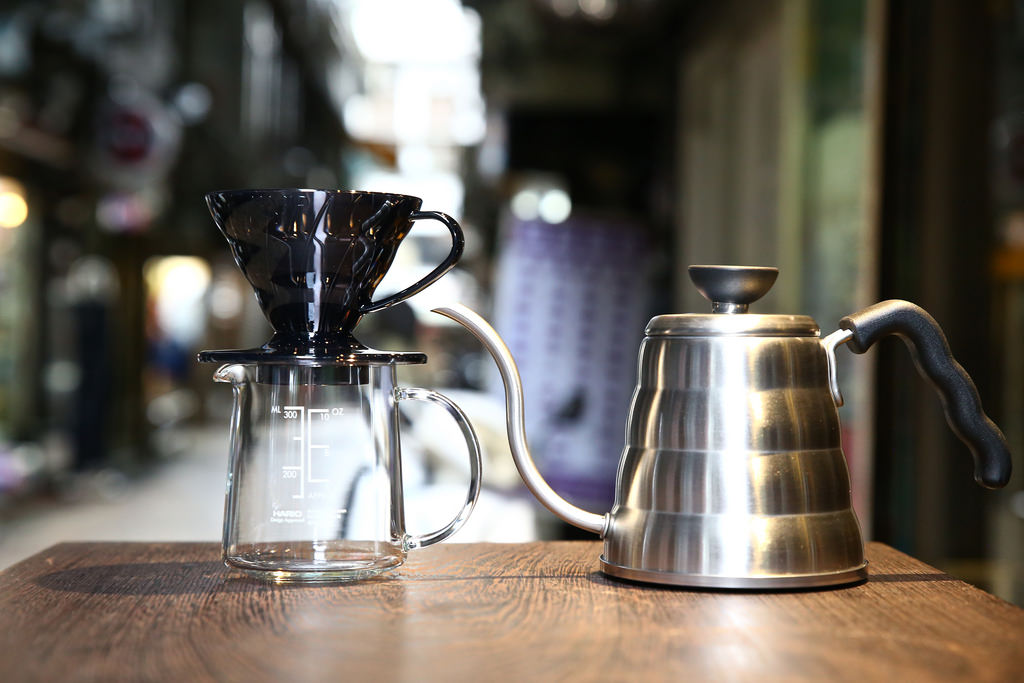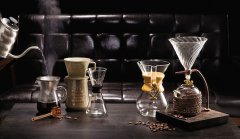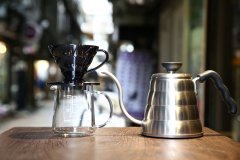What utensils do you need to make coffee by hand? Coffee experts hand brew coffee entry appliances brand recommendation

Professional coffee knowledge exchange more coffee bean information please follow the coffee workshop (Wechat official account cafe_style)
Coffee hand Pot recommendation-- complete Analysis of the Best hand Pot
Recommend the best entry choice for beginners of hand-made coffee! HARIO small Cloud stainless Steel hand Pot + HARIO V60 clear Black Coffee filter Cup
[HARIO] small Yunduo stainless steel thin mouth kettle (VKB-70HSV), which weighs about 330g and has a full water capacity of 700ml, is suitable for IH induction cooker. Lightweight and compact, suitable for women to use.
IMG_4747
[HARIO] V60 clear black resin filter cup coffee pot (ESD-01TB-EX-M), glass pot is made of heat-resistant glass, heat-resistant temperature difference: 120℃, with a scale marked 100Mel 300ml. It is most suitable for brewing 1MMI coffee for 2 people.
20 grams of coffee powder
Grinding scale # 6 (small Fuji Ghost Tooth Bean Mill)
The temperature of boiling water is 90 °C
Steaming time for 30 seconds
200 milliliters of water extracted
Recently, among the four key points of hand-brewing coffee, the concept of "high concentration and low extraction" has been mentioned, which has aroused a lot of extensive discussion. The usual method of Keelung Marujiao coffee is just in line with this concept. In order to achieve a clean and full-bodied taste, the focus is on the grinding scale. This time we use the Fujika R220 ghost tooth bean grinder, the scale is set at # 6. Compared with the usual scale of hand-brewed coffee, the coffee powder produced by this scale is quite thick.
I have shared with you before that there are two factors that affect the extraction rate, the grinding scale and the temperature of the boiling water. However, because the higher brewing water temperature can bring us better coffee aroma, we still use hot water at 90 °C for extraction. This time, using the Panamanian Don Alfredo sun-treated coffee beans baked by uncle, the whole sweet smell exploded, and the entrance was meek and sweet.
Opponent coffee beginners, there is an action that can not be ignored, that is, "steaming"! That is, the action of "steaming rice sauce", which is often mentioned in Japanese coffee books. Simply put, before the formal injection of water to brew, first inject a small amount of hot water to make the coffee powder absorb, and release carbon dioxide side by side, the amount of steaming water is about 1.5-2.5 times the weight of the coffee powder, depending on the depth of the baking. Generally speaking, deep-roasted coffee beans have a higher volume expansion rate, so they can absorb more hot water. The time of sitting and steaming is usually at 20 Murray for 30 seconds, which depends on the freshness of coffee beans. The fresher the coffee beans are, the more carbon dioxide will be emitted.
As can be seen from the film, formal water injection begins after steaming, pouring a smaller column of water on top of the coffee powder layer and circling it repeatedly from the inside to the outside. After a lot of practice, beginners can keep the water column stable without breaking and falling.
The first water injection stops when the coffee powder is flooded at a height close to the edge of the filter cup, and the amount of water injected is about 120 milliliters. After the water level drops slightly, continue the second water injection. This technique is called "water cut-off", and the concentration of coffee can be increased by interrupting water injection. When the water is injected for the second time, it can be found that the size of the water column is thicker and stops when the water level reaches about 1 cm at the edge of the filter cup.
Finally, when the coffee liquid in the glass below reaches the scale of 200ml, remove the coffee filter cup so that the water inside does not need to dry.
The special gooseneck design of the HARIO Cloud hand Pot allows the coffee spout to be close to the surface of the coffee powder, and the fine spout allows the coffee water column to be thick or thin, matching the different extraction concepts of the front and rear stages.
The coffee powder particles cut by the ghost tooth grinding cutter head are more square, which is very different from the flake particles of the cutting cutter head. In terms of flavor, the taste of the ghost tooth cutter head will be more round and sweet, and the aroma and acidity of the cutting cutter head will be more prominent.
Low-key calm transparent black, bring good aroma as well as a good mood. The name HARIO V60 comes from the fact that the tilt angle of the filter cup is 60 °. At the same time, it passes through the water diversion groove on the inner edge of the filter cup to achieve the effect of fast and slow down, so as to avoid the occurrence of astringent flavor caused by stagnant water.
HARIO V60 glass filter cup hand-brewed coffee teaching industry wind chong group newly listed
There are several main factors that affect the flavor of hand-brewed coffee, which are concentration, temperature, grain fineness and speed. First of all, concentration refers to the ratio of coffee powder to hot water, commonly known as "powder-to-water ratio". The commonly used powder-to-water ratio is between 1:12 and 1:15, that is, 1 gram of coffee powder with 15 grams of hot water. It should be noted that concentration and extraction rate are different concepts. Then comes the temperature, that is, the temperature of the hot water used to brew the coffee. The higher the temperature, the easier it is to extract the delicious and aromatic substances from the coffee powder; the temperature of the usual brewing water is about 85 ~ 93 degrees. When using lower water temperature, the sour taste of coffee is more obvious, while high temperature can bring better aroma. The fineness of coffee powder refers to the thickness of coffee powder when grinding, the finer the coffee powder, the more complete the extraction. Therefore, the concept of extraction rate mentioned just now is related to temperature and grain fineness, and high concentration does not mean high extraction rate. Take Tokyo Amber Coffee as an example, using more than 30 grams of coffee powder to extract 100 milliliters of coffee liquid, the concentration is extremely high, but at the same time using a very thick grain fineness, so the extraction rate is low, that is, the so-called "high concentration and low extraction" method. Finally, there is the speed, that is, the total time of the whole cooking process or the frequency of the water column, for example, we increase the extraction rate through static steaming and water cut-off, which are all affected by the control speed.
.
Important Notice :
前街咖啡 FrontStreet Coffee has moved to new addredd:
FrontStreet Coffee Address: 315,Donghua East Road,GuangZhou
Tel:020 38364473
- Prev

Japanese hand coffee maker which brand is good 5 cheap and practical coffee pots in Japan are recommended
Professional coffee knowledge exchange more coffee bean information please follow the coffee workshop (Wechat official account cafe_style) Coffee hand brewers recommend the best hand brewers completely explain how to get a good cup of coffee? Teach you how to make good coffee through 5 kinds of hand coffee pots. Compared with the general mechanical operation, the hand punching pot is more skillful and charming, through the fineness of the coffee powder,
- Next

What utensils do you need to make coffee by hand? Coffee experts hand brew coffee entry appliances brand recommendation
Professional coffee knowledge exchange more coffee bean information please follow the coffee workshop (Wechat official account cafe_style) Coffee hand brewers recommend the best hand brewers completely analyze and recommend the best entry choice for beginners of hand coffee! HARIO small Cloud stainless Steel hand Pot + HARIO V60 clear Black Coffee filter Cup [HARIO] small Cloud stainless Steel Fine mouth Pot (VKB-70HSV)
Related
- What is the Philharmonic pressure? How to use Philharmonic pressure to make delicious coffee
- Why does a hand grinder have more fine powder than an electric grinder?
- In addition to the hot mom, what is the difference between the versions of EK43 | ditting and Mahdi ek43?
- What kind of equipment do you need to make coffee by hand? Introduction to novice starter cooking equipment tools
- Espresso needs to be ground how thick and thin scale entry Italian Coffee Machine Bean Grinder investigation and Grinding course
- How much does it cost to open a small private cafe? How much does it cost to learn coffee? How to operate it?
- The difference between the flavor characteristics of hand-brewed coffee and coffee maker is hand-brewed coffee really better than coffee maker? Can I use a coffee machine to make coffee beans by hand?
- The difference between 01 and 02 of hario v60 filter cup what is the difference between 01 and 02 filter cup opening and cooking flavor
- What's the difference between the smart cup and the French kettle? Which is better, the French kettle or the Smart Cup?
- What's the difference between a smart cup and a V60 filter cup? The difference between the taste of smart cup and hand-brewed coffee

